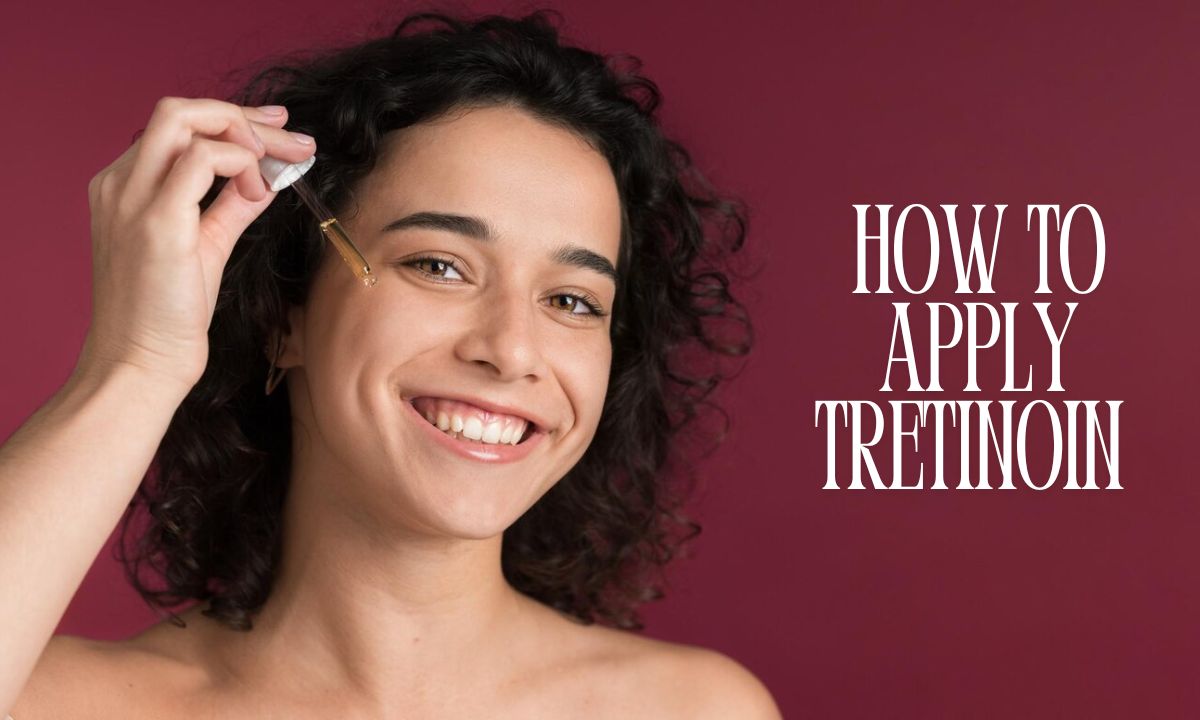Navigating the world of powerful skincare actives can feel overwhelming, especially when it comes to tretinoin—one of dermatology’s gold-standard ingredients for treating acne, fine lines, and uneven skin texture.
This comprehensive guide will walk you through exactly how to apply tretinoin correctly to maximize its benefits while minimizing potential irritation.
Whether you’re a tretinoin newbie or looking to refine your application technique, this article provides everything you need to know about incorporating this transformative retinoid into your skincare routine.
What is Tretinoin and How Does it Work?
Tretinoin (also known by brand names like Retin-A, Avita, and Altreno) stands out as a prescription-strength retinoid derived from vitamin A. Unlike over-the-counter retinol products, tretinoin is significantly more potent and works directly on skin cells without needing conversion.
When you apply tretinoin to your skin, it accelerates cell turnover—essentially teaching your skin to behave like younger, healthier skin.
This powerful retinoid works by binding to specific receptors in skin cells, promoting faster shedding of old, damaged cells while stimulating collagen production and new cell growth.
Tretinoin is available in several strengths:
- 0.025% – Mildest formulation, ideal for beginners
- 0.05% – Medium strength for those with established tolerance
- 0.1% – Strongest concentration, typically used for severe acne or advanced photoaging
It’s also formulated in different vehicles, including:
| Formulation Type | Best For | Notes |
| Cream | Dry or sensitive skin | Most moisturizing, less irritating |
| Gel | Oily or acne-prone skin | Dries quickly, can be more drying |
| Micro-encapsulated form | Sensitive skin | Time-released, reduces irritation |
| Lotion | Most skin types | Lightweight, spreads easily |
Dr. Leslie Baumann, renowned dermatologist and author, notes: “Tretinoin remains the most studied topical agent for treating both acne and photoaging, with decades of research supporting its efficacy. It’s truly the cornerstone of any serious anti-aging skincare routine.”
Benefits of Using Tretinoin
Understanding the potential benefits of tretinoin can help motivate consistent application, which is crucial for seeing results. When applied correctly, tretinoin can dramatically transform your skin over time.
Proven Benefits of Tretinoin:
- Acne treatment: Unclogs pores, prevents new breakouts, and reduces inflammation
- Anti-aging effects: Reduces fine lines, wrinkles, and improves skin firmness
- Hyperpigmentation reduction: Fades dark spots and evens skin tone
- Texture improvement: Refines rough patches and creates smoother skin
- Enhanced collagen production: Strengthens skin’s structural support
- Improved skin cell function: Creates healthier skin cells that behave more youthfully
Case Study: Tretinoin’s Long-Term Benefits A landmark 2-year study published in the Journal of Dermatological Treatment followed 204 participants using tretinoin. Results showed:
- 87% improvement in fine wrinkles
- 83% improvement in skin tone evenness
- 74% reduction in visible pores
- 91% of participants reported satisfaction with results after consistent nightly application
Before You Start: Essential Preparations
Before incorporating tretinoin into your skincare routine, proper preparation is essential for success. This powerful retinoid requires thoughtful integration to avoid unnecessary irritation.
Consult with a Dermatologist
While this guide provides detailed application advice, nothing replaces personalized guidance from a dermatologist. A professional can:
- Assess whether tretinoin is appropriate for your skin concerns
- Prescribe the correct strength based on your skin type and condition
- Identify potential contraindications or interactions with other products
- Provide a customized introduction schedule based on your skin’s sensitivity
Skin Assessment
Be honest about your skin’s current condition. If you’re experiencing active inflammation, a damaged moisture barrier, or excessive dryness, you may need to restore skin health before starting tretinoin treatment. Signs your skin might not be ready include:
- Stinging sensation when applying basic moisturizer
- Persistent redness or flaking not caused by specific products
- Heightened sensitivity to products previously well-tolerated
- Excessive oiliness (often a sign of dehydration)
Setting Realistic Expectations
Tretinoin is not an overnight miracle. Understanding the typical timeline for results can prevent disappointment:
- Weeks 1-4: Possible purging (temporary acne flare-up), mild irritation
- Weeks 4-8: Initial improvements in texture and pore appearance
- Months 3-6: Noticeable reduction in fine lines and pigmentation
- 6+ months: Significant improvement in all skin concerns with continued use
Supplies You’ll Need for Proper Tretinoin Application
Creating a supportive skincare routine around your tretinoin application is crucial for success. Here’s what you’ll need:
Essential Products:
- Gentle, non-foaming cleanser: Look for pH-balanced formulas without harsh surfactants that can strip skin. Avoid cleansers with active ingredients like salicylic acid or glycolic acid when starting tretinoin.
- Fragrance-free moisturizer: Hydration becomes critical when using tretinoin. Choose moisturizers with barrier-supporting ingredients like ceramides, niacinamide, or hyaluronic acid. Moisturizer plays a key role in reducing tretinoin irritation.
- Broad-spectrum sunscreen (SPF 30+): Tretinoin increases photosensitivity, making daily sunscreen non-negotiable. Choose formulas specifically designed for facial use to ensure comfortable daily wear.
- Optional barrier repair products: If you experience irritation, products containing ingredients like centella asiatica, panthenol, or colloidal oatmeal can help calm inflammation.
Recommended Product Combinations:
| Skin Type | Recommended Cleanser | Recommended Moisturizer | Recommended Sunscreen |
| Dry/Sensitive | Creamy, hydrating formulas | Rich creams with ceramides | Mineral-based formulations |
| Oily/Acne-Prone | Gentle gel cleansers | Lightweight gel moisturizers | Oil-free, matte finish SPF |
| Combination | Balancing, mild foaming cleansers | Lotion-weight hydrators | Hybrid chemical/physical sunscreens |
| Mature | Cream or oil cleansers | Peptide-rich moisturizers | Hydrating formulas with antioxidants |
Step-by-Step Tretinoin Application Guide
Following the correct application process is crucial for maximizing tretinoin’s benefits while minimizing potential irritation. Here’s a detailed, step-by-step approach to tretinoin application:
Evening Cleansing Routine
- Thoroughly cleanse your face: Use lukewarm (never hot) water and a gentle cleanser to remove all makeup, sunscreen, and daily buildup. Pat—don’t rub—your face dry with a clean towel.
- Allow skin to fully dry: This is a critical step often overlooked. Wait 20-30 minutes after cleansing before applying tretinoin. When skin is damp, tretinoin penetrates more deeply, potentially causing increased irritation.
“The ‘wait time’ before tretinoin application is backed by science. Wet or damp skin increases product penetration by up to 10 times, which can significantly increase irritation when using potent retinoids.” – Dr. Shereene Idriss, Board-Certified Dermatologist
Proper Application Technique
- Dispense a pea-sized amount: This small quantity is sufficient for your entire face. Using more won’t increase effectiveness but will increase irritation. For beginners, you can divide this small amount into several dots placed strategically around the face.
- Apply to specific zones: Gently dot the tretinoin on your forehead, cheeks, chin, and nose, then spread using upward and outward motions. Avoid harsh rubbing—let the product absorb naturally.
- Areas to avoid or use with caution:
- Eye area: Stay at least 1 cm away from the eyes
- Corners of nose and mouth: These areas are more prone to irritation
- Lips and nostrils: Avoid completely
- Neck and hands: Some dermatologists approve application to these areas, but use less product and reduced frequency
- Special technique for sensitive areas: If you want to treat areas like the neck or around the eyes (under dermatologist guidance), you can dilute tretinoin’s strength by applying moisturizer to these areas first, then applying a smaller amount of tretinoin on top.
Post-Application Care
After applying tretinoin, wait 10-15 minutes before following with moisturizer. This allows the tretinoin to properly absorb and begin working. Apply a generous layer of moisturizer to seal in hydration and mitigate potential dryness.
For extremely sensitive skin, you can use the “sandwich method”:
- Apply moisturizer to clean, dry skin
- Wait 15-20 minutes
- Apply tretinoin
- Wait another 15-20 minutes
- Apply a second layer of moisturizer
Tretinoin Application Frequency: Building Your Routine
The key to successful tretinoin use is gradual introduction. Most skin irritation occurs when people apply tretinoin too frequently too soon. Here’s how to build your routine:
Starting Slow: The Beginner’s Schedule
Week 1-2: Apply tretinoin just once or twice per week. This minimal exposure allows your skin to begin adapting with minimal irritation.
Weeks 3-4: If your skin has responded well, increase to every third night.
Weeks 5-6: Increase to every other night if tolerated.
Weeks 7+: Some people can eventually work up to nightly application, while others find that alternate nights provide the best balance of results and comfort.
The Buffer Method Explained
“Buffering” refers to applying moisturizer before tretinoin to reduce its initial impact on the skin. This technique is especially helpful for beginners and those with sensitive skin.
Standard buffering:
- Cleanse face
- Apply moisturizer to damp skin
- Wait 20-30 minutes
- Apply tretinoin
- Wait 15 minutes
- Apply second layer of moisturizer if needed
As your skin adapts, you can transition to applying tretinoin directly to dry skin before moisturizer.
Signs You’re Ready to Increase Frequency
Look for these indicators that your skin is adapting well:
- No persistent redness or flaking
- No burning or stinging sensation when applying other skincare products
- Overall comfort and minimal sensitivity
- Initial signs of improvement in skin texture or clarity
Maintenance Schedule Options
Once your skin has fully adjusted to tretinoin, most dermatologists recommend these maintenance schedules:
| Skin Type | Recommended Schedule | Additional Notes |
| Normal/Combination | Every night | May need to reduce during winter months |
| Sensitive | Every other night | May incorporate “tretinoin holidays” during sensitive periods |
| Dry | 3-4 times weekly | Focus on hydration on off nights |
| Oily/Acne-Prone | Every night | May tolerate higher concentrations eventually |
Managing Side Effects When Applying Tretinoin
Even with perfect application technique, some side effects are common when using tretinoin, especially during the initial adaptation phase. Understanding how to manage these effects can help you stay consistent with your nightly application.
Common Side Effects and Management
Dryness and Flaking
- Management: Increase moisturization, particularly with humectants like hyaluronic acid and emollients. Consider using a humidifier in your bedroom.
- Products to try: Look for moisturizers containing ceramides, squalane, or glycerin.
Redness and Irritation
- Management: Temporarily reduce frequency of application or use the sandwich method.
- Products to try: Calming ingredients like centella asiatica, green tea extract, or colloidal oatmeal.
Purging (Temporary Breakout Phase)
- Management: Continue use unless breakouts are significantly inflamed or painful. Purging typically peaks at 2-3 weeks and resolves by week 6.
- Products to try: Gentle spot treatments with ingredients like niacinamide or azelaic acid (approved by your dermatologist).
Products to Avoid While Using Tretinoin
Certain skincare ingredients can exacerbate irritation when used alongside tretinoin. Consider avoiding:
- Physical exfoliants: Scrubs, brushes, or harsh cloths
- Chemical exfoliants: AHAs, BHAs, enzymes (may be reintroduced gradually later)
- Astringent toners: Especially those containing alcohol
- Benzoyl peroxide: Can deactivate tretinoin unless formulated specifically to work together
- Fragrance and essential oils: Common irritants
Emergency Irritation Protocol
If you experience severe irritation, follow this recovery plan:
- Pause tretinoin use immediately
- Simplify routine to gentle cleanser and rich moisturizer
- Apply 1% hydrocortisone cream sparingly if needed (max 3 days)
- Protect skin with mineral sunscreen
- Resume tretinoin at lower frequency once skin normalizes
Dr. Amy Wechsler suggests: “Think of tretinoin as a marathon, not a sprint. Taking a break when needed doesn’t mean failure—it means you’re listening to your skin and allowing it to adapt at its own pace.”
Special Considerations for Tretinoin Application
Certain situations require special attention when using tretinoin in your skincare routine:
Seasonal Adjustments
Your skin’s tolerance for tretinoin may change with the seasons:
- Winter: Cold air and indoor heating can decrease skin’s natural moisture, requiring:
- Reduced frequency (consider dropping by 1-2 applications weekly)
- Increased moisturization
- Addition of hydrating serums containing hyaluronic acid
- Summer: Higher humidity can improve tolerance, but increased sun exposure requires:
- Diligent sunscreen application and reapplication
- Possibly switching to a lower concentration if spending extended time outdoors
Combining Tretinoin with Other Actives
Certain ingredients can complement tretinoin, while others may increase irritation:
Compatible ingredients (use on alternate nights or mornings):
- Niacinamide (strengthens skin barrier)
- Hyaluronic acid (hydrates without interference)
- Vitamin C (use in morning only for antioxidant protection)
- Azelaic acid (works synergistically for acne and pigmentation)
Avoid combining (at least initially):
- Alpha-hydroxy acids (glycolic acid, lactic acid)
- Beta-hydroxy acids (salicylic acid)
- Benzoyl peroxide (can deactivate tretinoin)
- Physical exfoliants
- Other retinoids
Application During Pregnancy and Breastfeeding
Important: Tretinoin is generally not recommended during pregnancy or breastfeeding. Consult your obstetrician and dermatologist for guidance on safe alternatives like bakuchiol or azelaic acid.
Travel Considerations with Tretinoin
When traveling:
- Adjust frequency when visiting extremely dry or humid climates
- Pack barrier repair products as precaution
- Consider TSA requirements (prescription label may be needed)
- Protect tretinoin from excessive heat and direct sunlight
Tretinoin Application Myths Debunked
Several misconceptions about tretinoin application persist. Let’s clear these up:
Myth 1: “More is better”
Reality: Using more than a pea-sized amount won’t speed results but will dramatically increase irritation. Tretinoin works at a cellular level, and excess product cannot accelerate this process.
Myth 2: “Daytime application is fine with enough sunscreen”
Reality: Tretinoin is partially deactivated by sunlight and increases photosensitivity. Even with excellent sun protection, daytime application reduces efficacy and increases risk of irritation.
Myth 3: “Irritation means it’s working”
Reality: While mild flaking can be normal during adjustment, significant irritation is not a sign of effectiveness but of barrier damage. The best results come from consistent use at a level your skin can tolerate without significant irritation.
Myth 4: “You should see results within weeks”
Reality: While some improvements in texture may appear within 4-6 weeks, significant results for anti-aging typically take 3-6 months of consistent application. Acne improvement usually begins around 12 weeks.
Myth 5: “You can’t use moisturizer with tretinoin”
Reality: Not only can you use moisturizer with tretinoin, but proper hydration is essential for successful treatment. Moisturizer can be applied before, after, or both, depending on your skin’s needs.
Maximizing Your Tretinoin Results
To get the most from your tretinoin treatment, consider these enhancement strategies:
Complementary Skincare Ingredients
Certain ingredients work particularly well alongside tretinoin:
- Niacinamide: Strengthens skin barrier, reduces inflammation, and helps fade hyperpigmentation
- Hyaluronic acid: Provides hydration without interference
- Ceramides: Replenish skin’s natural barrier components
- Peptides: Support collagen production alongside tretinoin
- Antioxidants: Protect skin from environmental damage during daytime hours
Diet and Lifestyle Factors
Support your skin’s health from the inside out:
- Hydration: Aim for 2-3 liters of water daily
- Antioxidant-rich foods: Colorful fruits and vegetables support skin healing
- Omega-3 fatty acids: Help maintain skin’s lipid barrier
- Adequate sleep: Critical for skin cell regeneration
- Stress management: Chronic stress can exacerbate skin sensitivity
Monitoring Progress Effectively
Track your tretinoin journey properly:
- Take baseline photos: Use consistent lighting and angles
- Document your protocol: Keep notes on frequency, buffer methods used, and complementary products
- Monthly progress photos: Look for subtle changes in texture and clarity
- Adjust expectations: Different concerns respond at different rates
- Texture improvement: Often first (4-8 weeks)
- Acne reduction: 12+ weeks
- Fine lines: 3-6 months
- Deep wrinkles: 6-12 months
Troubleshooting Your Tretinoin Application
Even with careful application, you may encounter challenges with your tretinoin routine. Here’s how to address common issues:
Persistent Irritation
If irritation continues beyond the normal adjustment period:
- Reduce concentration: Consider switching to a lower strength
- Adjust frequency: Use tretinoin less frequently but consistently
- Buffer more aggressively: Apply multiple layers of moisturizer before and after
- Consider formulation change: Cream formulations are typically less irritating than gels
- Try micro-encapsulated form: Retin-A Micro or similar formulations release more gradually
Plateau in Results
If progress seems to stall:
- Review your consistency: Even occasional missed applications can impact results
- Consider strength adjustment: If well-tolerated, you might need a higher concentration
- Add complementary ingredients: Niacinamide, vitamin C, or peptides can enhance results
- Reassess your complete routine: Other products might be interfering
- Consult your dermatologist: Professional treatments like microneedling or peels can boost tretinoin’s effects
Application on Specific Problem Areas
For targeting specific concerns:
Dark spots/hyperpigmentation:
- Apply a slightly larger amount directly to spots
- Consider adding tranexamic acid or kojic acid in your morning routine
Deep wrinkles:
- Use the “spot treatment” approach, applying slightly more product to these areas
- Add peptide serums to the area in the morning
Chest and neck:
- Use lower concentration or frequency
- Always buffer with moisturizer
- Increase sunscreen diligence on these areas
Real User Experiences with Tretinoin Application
Case Study 1: Sarah’s Acne Journey
Sarah (31) struggled with hormonal acne for years before starting tretinoin 0.025% cream.
Application Approach:
- Started with twice-weekly application using the sandwich method
- Experienced minor purging in weeks 3-4
- Gradually increased to every-other-night by month 2
- Reached daily application by month 3
Results Timeline:
- Week 6: Noticed fewer new breakouts
- Month 3: 50% reduction in acne lesions
- Month 6: 90% clearance with only occasional hormonal breakouts
- Month 12: Complete resolution with significant improvement in acne scarring
Key Lesson: “Patience and consistency were crucial. The purging phase almost made me quit, but pushing through those tough weeks was worth it.”
Case Study 2: Michael’s Anti-Aging Experience
Michael (48) began tretinoin 0.05% for fine lines and sun damage.
Application Approach:
- Started with once-weekly application directly on dry skin
- Added hyaluronic acid serum to morning routine to combat dryness
- Gradually built to three times weekly by month 2
- Maintained three times weekly long-term
Results Timeline:
- Month 2: Improved skin texture and glow
- Month 4: Noticeable reduction in fine lines around eyes
- Month 8: Friends commented on his “refreshed” appearance
- Year 1: Significant improvement in sun spots and deeper wrinkles
Key Lesson: “Finding my ideal frequency—three times weekly rather than daily—was game-changing. More wasn’t better for my skin.”
Conclusion: Mastering Tretinoin Application
Learning how to apply tretinoin correctly is a journey that requires patience and attention to your skin’s unique needs. The power of this remarkable retinoid lies not just in its proven effectiveness but in your application technique and consistency.
Remember these key principles for successful tretinoin use:
- Start low and slow: Begin with the lowest concentration and infrequent application
- Use the correct amount: A pea-sized quantity is sufficient for your entire face
- Time your application properly: Apply to completely dry skin in your evening routine
- Support your skin barrier: Never compromise on moisturization and sun protection
- Be patient: The most dramatic results come with consistent long-term use
Whether you’re fighting acne, seeking to diminish signs of aging, or addressing uneven skin tone, proper tretinoin application can transform your skin over time. The investment in learning correct technique pays dividends in improved skin health for years to come.
FAQs About Applying Tretinoin
Q: Can I use tretinoin during the day?
A: No, tretinoin should only be used at night. It breaks down in sunlight, making it less effective, and increases your skin’s sun sensitivity. Always use sunscreen during the day when on tretinoin treatment.
Q: How long before I see results from tretinoin?
A: Initial improvements in skin texture may appear within 4-6 weeks. Acne typically begins to improve around 12 weeks, while significant anti-aging results usually take 3-6 months of consistent nightly application.
Q: Can I apply tretinoin around my eyes?
A: The eye area is particularly sensitive, but some dermatologists recommend careful application of a lower concentration tretinoin around the orbital bone (not on the eyelids or too close to eyes). Always consult your dermatologist before treating this area.
Q: Should I stop using tretinoin if my skin peels?
A: Mild flaking is normal during the adjustment period. However, if you experience significant peeling, redness, or discomfort, reduce application frequency until your skin adapts. Don’t stop completely unless irritation is severe.
Q: Can I use tretinoin with vitamin C?
A: Yes, but ideally at different times. Most dermatologists recommend vitamin C in your morning routine and tretinoin at night for optimal results and minimal irritation.
Q: Is prescription tretinoin better than over-the-counter retinol?
A: Prescription tretinoin is significantly more potent than over-the-counter retinol products. Retinol must convert to retinoic acid in the skin, while tretinoin is already in its active form, making it more effective but potentially more irritating.










